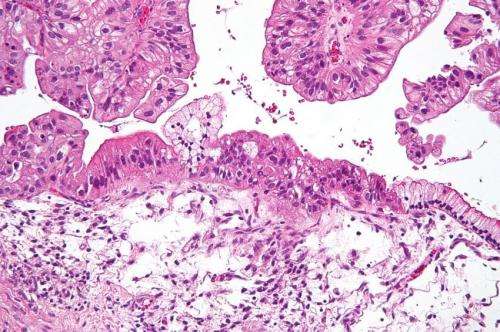Intermediate magnification micrograph of a low malignant potential (LMP) mucinous ovarian tumour. H&E stain. The micrograph shows: Simple mucinous epithelium (right) and mucinous epithelium that pseudo-stratifies (left - diagnostic of a LMP tumour). Epithelium in a frond-like architecture is seen at the top of image. Credit: Nephron /Wikipedia. CC BY-SA 3.0
A new imaging test may provide the ability to identify ovarian cancer patients who are candidates for an emerging treatment that targets a key enzyme cancer cells need to survive. Currently, epithelial ovarian cancer patients with BRCA1 mutations are considered candidates for the treatment, but there is no method to measure the enzyme levels to help guide treatment choices. Researchers from the Perelman School of Medicine at the University of Pennsylvania used a new type of imaging to do just that in hopes of finding patients who may benefit from treatment to block the enzyme, including patients without the BRCA mutation. Researchers will present their findings at the upcoming 2017 American Association for Cancer Research Annual Meeting in Washington, D.C. (Abstract 3716).
Researchers used the imaging to see Poly (ADP-ribose) Polymerase 1 (PARP-1), an enzyme that helps damaged cancer cells repair their DNA and survive, and found drugs that block that enzyme have an equal to or even greater impact on treatment than restoring the BRCA1 mutation.
PARP-1 is already a target of emerging therapies for breast and ovarian cancer. By using a PARP inhibitor, doctors can trap the enzyme on cancer DNA, causing that cell to form poisonous lesions and die. This new research could help point the way towards identifying patients most likely to benefit from treatment with PARP inhibitors.
"Research exists that shows PARP inhibitors can be effective in the treatment of BRCA1 mutated cancer, but there are no good existing methods to explore how mutations within BRCA genes effect PARP-1 expression," said the study's lead author Mehran Makvandi, PharmD, RPh, ANP, an instructor of Radiology at Penn. "We wanted to validate our radiotracer technology as a quantitative biomarker for PARP-1 with the goal of selecting patients who could benefit from PARP inhibitor therapy."
To tackle the problem, Penn researchers used two kinds of ovarian cancer cells, one with the BRCA1 mutation and one without. They used genetic editing to remove PARP-1 in BRCA1 mutant cancer cells, and then exposed the cells to PARP inhibitors and cisplatin, a chemotherapy drug. They then repeated the experiment with the two types of cancer cells, but this time they left PARP-1 in place and compared results.
"We were able to compare the effects of losing PARP-1 to the effects of gaining BRCA1," Makvandi said. "For a lot of the PARP inhibitors, losing PARP-1 led to as much or even more resistance to the treatment as the restoration of BRCA1 function. Furthermore, sensitivity to PARP inhibitors was reflected in the measures of PARP-1 expression provided by our new radiotracer method. "
In addition to the work in the lab, researchers also used imaging to confirm their findings in patients, making them the first team to use clinical PET scans to measure PARP-1 in a series of patients with epithelial ovarian cancer. To accomplish this, the team used a new PET imaging agent called FluorThanatrace (FTT) that was developed by the study's co-author Robert Mach, PhD, the Britton Chance Professor of Radiology at Penn. The team says that this multi-disciplinary research effort brought the research together and opened the door to the possibility of seeing PARP-1 in action.
"PARP-1 expression has had only limited evaluation as a predictive biomarker for PARP inhibitor therapy, in part due to the lack of good tools for measuring levels in patients. We now have a technology that will allow us to clinically assess PARP-1 in a non-invasive way," Makvandi said.
Makvandi also said FTT can be useful in viewing PARP inhibitors in action to see if the blocking is working.
"We can quantify PARP-1 at baseline, and then use serial imaging studies to directly measure the effects of PARP inhibitors," Makvandi said.
"This is a study we could not have done without a multi-disciplinary team," added David Mankoff, MD, PhD, the Gerd Muehllehner Professor of Radiology and one of the study's co-authors. "When you think about all of the pieces that had to come together for this research, bringing together physicists, chemists, biologists, and bringing it together with the imaging component, it really shows the multidisciplinary approach Penn is taking is key to tackling these issues."





















